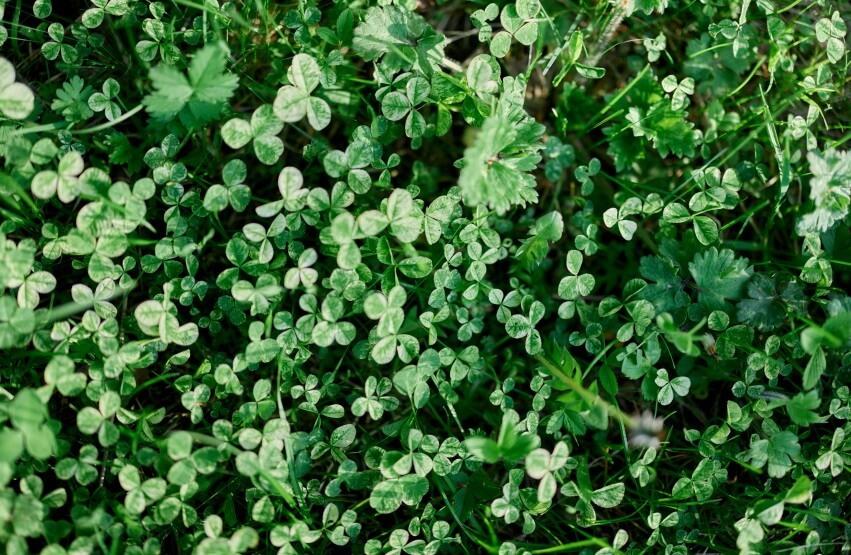Step into the enchanting world of gardening, where a petite but vibrant groundcover is stealing the spotlight – the micro clover lawn. Imagine a lush, green carpet underfoot that not only enhances the beauty of your garden but also brings a host of benefits to both the environment and your gardening endeavors. As we delve into the universe of micro clover, we uncover a delightful alternative to traditional lawns, rich with advantages and a few considerations to ponder. Join us on this horticultural journey to explore the charm, perks, drawbacks, and the secrets of cultivating a flourishing micro clover lawn – a tiny treasure trove in the realm of gardening.
If you are interested in this topic, you can also read
<<Benefits Of Hydroponics >> and <<Benefits Of Weeds >> articles.
What Is Micro Clover Lawn?
Microclover is a small marvel that seamlessly blends with different grass lawns, offering a touch of neatness without overpowering the turfgrass landscape. Whether you refer to it as Trifolium repens v. pipolina or Trifolium repens v. pirouette, microclover is essentially the miniature edition of the familiar Dutch white clover (Trifolium repens).
History Of Micro Clover Lawn
Back in the days before the 1950s, when broadleaf herbicides became the go-to, microclover was a staple in lawn seed mixes. The reason? Microclover and grass form a dynamic duo. Picture this: the little rebel microclover grabs hold of fertilizer from the air and generously delivers it down to the soil, a collaboration that has stood the test of time well before modern lawn care routines took the stage. So, in a nutshell, microclover isn’t just your garden-variety ground cover – it’s a piece of living history in your lawn [1].
What makes microclover unique is its growth pattern. Unlike its Dutch counterparts, it doesn’t form clumps. When incorporated into your lawn, it creates a seamless tapestry of uniform greenery, avoiding the messy look often linked to weeds that need to be removed.
While microclover has long been a favored lawn alternative in Europe, it’s now making waves in the United States. Two standout varieties, “Pirouette” and “Pipolina” (Trifolium repens var. Pirouette and Pipolina), have become the darlings of lawns across the nation. Reaching a modest height of 4-6 inches. These microclover variants boast a remarkable tolerance for close mowing, handling trims down to 3 inches with ease – a feature that sets them apart from their white and red clover relatives. So, in the realm of lawns, microclover isn’t just a latecomer; it’s a game-changer, redefining the way we envision and care for our green spaces [2].
Why Micro Clover Lawns?
Microclover, a unique variety of petite white clover, serves as both a supplement for your turfgrass and an alternative to the traditional grassy lawn. Despite its small stature, this unassuming plant packs a punch, resembling a weed at first glance but offering a plethora of benefits as a ground cover. Consider it the four-leaf clover of your yard, bringing luck by acting as a protective shield against diseases, pests, and various lawn woes.
Microclover emerges as a neat and charming choice for homeowners seeking a low-maintenance, eco-friendly ground cover to enhance their grassy lawns. With its diminutive stature and petite leaves, microclover brings a tidy aesthetic to your outdoor space without demanding much upkeep.
In comparison to its more conventional counterpart, white clover, microclover is the understated sibling that hugs the ground, sporting smaller leaves and fewer flowers. Unlike the clumpy growth pattern of typical clover, microclover opts for a more uniform spread, creating a visually appealing carpet of greenery.
While it might not be a miraculous fix-all, and despite the “micro” in its name, microclover has a knack for transforming your lawn into a beautiful landscape. It’s not as prone to flowering as traditional white clover, especially in its initial season, but it does contribute a subtle bloom, more noticeable as it matures into its second season. So, think of microclover as the subtle artist in your lawn palette, adding a touch of elegance without overwhelming the canvas [3].
Pros And Cons Of Micro Clover Lawns
Advantages Of Micro Clover Lawns
Choosing clover, and particularly microclover, for your lawn comes with a bundle of benefits. Here are the reasons why it’s a complete game-changer for your outdoor space :
- Erosion Control: Clover lawn acts as a natural erosion deterrent, helping to maintain the stability of your soil.
- Weed Management: It out-competes common weeds, creating a dense ground cover that minimizes weed growth.
- Nitrogen Fixation: By pulling nitrogen from the air and depositing it into the soil, clover becomes a natural fertilizer for surrounding plants.
- Green Manure: As a nutrient-rich ground cover, clover contributes to the soil’s fertility, functioning as a green manure.
- Low-Maintenance: Clover reduces the need for frequent lawn maintenance, cutting down on both time and effort.
- Water Conservation: It conserves water, making it a sustainable choice for regions prone to water scarcity.
- Energy Efficiency: With its lower growth, clover lessens the need for frequent mowing, reducing energy consumption.
- Chemical Reduction: Clover minimizes the need for harsh chemicals such as fertilizers and pesticides.
- Aeration and Dethatching: The need for these lawn interventions is significantly reduced with a clover-rich lawn.
- Pollinator Attraction: Clover entices beautiful pollinators, enhancing the biodiversity of your outdoor space.
- Disease Resistance: It helps deter grass fungus and diseases, promoting a healthier lawn.
- Pest Resistance: Clover’s presence discourages common lawn pests like grubs.
- Cold Weather Hardy: Thriving in cold weather, clover remains resilient even in chilly conditions.
- Compact Soil Growth: While it performs best in aerated soil, clover can adapt and flourish in compacted soil.
For those looking to simplify their lawn care routine, an all-clover lawn is a hassle-free option, eliminating the need for additional fertilizers. Microclover, in particular, takes it up a notch by staying lush and green throughout the year, seamlessly blending into various lawn types like tall fescue, fine fescue, Kentucky bluegrass, and perennial ryegrass. It’s not just about a lawn; it’s about creating a resilient, attractive, and environmentally friendly outdoor haven [4].
Disadvantages Of Micro Clover Lawns
While clover, especially microclover lawn, has its merits, it’s essential to consider some potential downsides before committing to it in your lawn:
- Rabbit Magnet: Rabbits are avid fans of clover, so growing it may inadvertently increase the local rabbit population, posing a challenge for those not keen on their presence.
- Summer Dormancy: Microclover may struggle during the peak of summer when other grasses enter dormancy, potentially leading to bare spots and erosion.
- Sunlight Requirements: Microclover demands at least four hours of full sun daily and doesn’t fare well in shaded areas, making it unsuitable for lawns under trees or near buildings.
- Costly Seeds: Micro-clover seeds can be relatively expensive, particularly when compared to white clover, impacting the initial investment for lawn establishment.
- Foot Traffic Sensitivity: Microclover is less resilient to foot traffic, making it less suitable for play areas without mixing it with turfgrass.
- Disease Susceptibility: While clover, in general, is disease-resistant, microclover can be susceptible to southern blight disease in regions with high humidity and warm night temperatures.
- Allergen Concerns: Clover attracts pollinators, which may not be ideal for individuals or children with bee sting allergies.
- Limited Lifespan: Microclover is a perennial but has a relatively short lifespan, requiring reseeding every two to three years for a consistently lush lawn.
- Soil And Herbicide Sensitivity: Microclover struggles in sandy soil and is sensitive to broadleaf herbicides, risking wilting or death if treated with these chemicals.
- Germination Challenges: Microclover seeds germinate more slowly than grass seeds and may not germinate uniformly, necessitating spot reseeding for optimal results.
In weighing the pros and cons, it’s crucial to align your lawn goals with the characteristics of microclover to ensure a successful and satisfying landscaping experience [5, 6].
Micro Clover Lawns Vs. Traditional Lawns
Having a micro clover lawn makes it easy to achieve a rich, dense, and perfectly groomed yard. Plus, it eliminates the high maintenance usually associated with traditional turf grass. This is why micro-clover takes the forefront. Here are several key benefits of a micro clover lawn over a traditional lawn:
- Water-Wise Advantage: Once established, micro-clover lawns demand, on average, 25% less water than turf grass to maintain their vibrant green appearance.
- Self-Sustaining Nitrogen: Micro-clover lawn boasts the unique ability to produce its own nitrogen, significantly reducing the need for nitrogen fertilizer compared to traditional grass. While other nutrients like phosphorus (P), potassium (K), and others may still be necessary, the reliance on nitrogen is notably diminished.
- Slower Growth, Less Mowing: Thanks to its slower growth rate, micro-clover stays shorter than turf grass, meaning less frequent mowing. This characteristic adds a touch of convenience to lawn maintenance.
- Pet-Friendly Resilience: Microclover emerges as an excellent choice for households with pets. Unlike turf grass, it displays remarkable resilience to pet urine, steering clear of the yellow or brown discoloration often seen with traditional lawns. However, it’s worth noting that if pets consume a substantial amount, it may cause some gastrointestinal upset.
In the battle between micro-clover lawns and traditional grass lawns, the micro variety demonstrates itself as a water-efficient, low-maintenance, and pet-friendly substitute. It paves the way to a vibrant lawn with significantly reduced upkeep needs [7, 8].
How To Grow Micro Clover Lawn?
Growing a micro-clover lawn is a straightforward process that, once established, requires less maintenance than a traditional grass lawn. Here’s a step-by-step guide to get you started:
- Prepare the Soil:
- Till the soil to a depth of 4-6 inches to create a loose, aerated bed.
- Boost soil fertility by adding compost.
- Soil pH Adjustment:
- Check the soil’s pH level; micro-clover performs best in soils with a pH level of 6 or 7.
- If needed, adjust the pH by adding lime to the soil.
- Level the Surface:
- Rake the soil to create a smooth and level surface.
- Seed Spreading:
- Use a seed spreader to distribute micro-clover seeds evenly across the yard.
- Watering:
- Provide frequent but light watering to keep the soil consistently moist.
- Avoid overwatering; the goal is to maintain moisture without waterlogging the soil.
- Water the micro-clover seeds once daily until they are established. Germination typically takes 7-14 days.
- Germination Check:
- After germination, assess the lawn for any gaps or patches where the seeds did not grow.
- Fill in these areas by spreading more micro-clover seeds.
- Established Maintenance:
- Once established, reduce watering frequency to one to two times a week.
- When the micro-clover lawn reaches the desired size, mow it to prevent it from becoming too tall.
- Ideal Planting Time:
- The ideal time to plant micro-clover depends on your geographic location and local climate.
- Optimal planting times are either in the spring or fall.
- Seed Reserves: Reserve about 10-15% of the seeds to fill in any patches that may occur during growth.
- Companion Planting: Micro-clover tends to thrive when sharing space with grasses and other plants.
Remember that micro-clover is a cooperative companion for various plants and can enhance the overall health and aesthetics of your lawn. With a bit of care during the initial stages, you can enjoy a low-maintenance, green, and resilient micro-clover lawn [9].
When To Plant Micro Clover Lawn?
Timing is crucial when it comes to sowing Micro-clover for optimal growth and establishment. Here are some guidelines depending on the season:
Spring Sowing
- Begin sowing Microclover as early as two weeks before your last frost date in the spring.
- This timeframe allows for the seeds to take advantage of the warming weather and establish themselves before the heat of summer.
Fall Sowing
- If you’re opting for a fall planting, aim to sow at least 8 weeks before your first average frost date.
- This provides sufficient time for the perennial clover plants to develop robust root systems before the onset of freezing temperatures.
Temperature Considerations
- Clover tends to prefer cooler temperatures for germination and initial growth.
- Avoid planting during the hottest part of the year to ensure favorable conditions for the successful establishment of your Micro-clover.
By adhering to these timing recommendations, you set the stage for a successful Micro-clover lawn, whether you’re sowing in the rejuvenating spring or the preparatory fall [10].
Where To Buy The Best Micro Clover Lawn Seeds?
1. American Meadow
American Meadow is a trusted online shop where you can confidently purchase your micro clover seeds. Known for its reliability, this platform likely provides a seamless buying experience and quality products.
2. Rural Supplier
Rural Supplier is another reputable source for acquiring the necessary micro clover seeds. Their offering, the Luxury Micro Clover Lawn, is a thoughtfully crafted blend of Chewing Fescue, Meadow Grasses, and Pipolina (micro clover). This mix is designed to create a low-maintenance and environmentally friendly lawn that reduces the need for fertilizers and water.
3. Eartheasy
Eartheasy stands out as an online shop that caters to your seed needs by providing a unique product – the MicroLawn Grass Seed & Microclover Blend. The blend includes Turf-Type Tall Fescue, Microclover, and 4N Perennial Ryegrass, offering a balanced composition for new lawns. A 5 lb. bag covers 1,000 square feet, making it convenient for various lawn sizes.
4. Nature’s Seed
- Nature’s Seed is another reliable online shop offering a variety of packs for micro clover seeds. When browsing their selection, you can find options tailored to your specific lawn needs. Consider exploring the different packs available to determine the best fit for your lawn size and preferences.
Note: Before making a purchase, always check customer reviews, product descriptions, and any additional information provided by these online shops to ensure that the micro clover seeds you choose align with your lawn goals and regional climate conditions.














